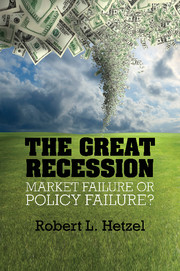Book contents
- Frontmatter
- Contents
- Figures
- Tables
- Preface
- One The 2008–2009 Recession
- Two Recessions
- Three The Great Contraction
- Four Monetary Policy and Bank Runs in the Great Depression
- Five Vigorous Recovery and Relapse
- Six Interwar International Monetary Experiments
- Seven Identifying the Shocks that Cause Recessions
- Eight From Stop-Go to the Great Moderation
- Nine Controlling Bank Risk Taking
- Ten The Housing Crash
- Eleven Bubble Trouble
- Twelve What Caused the Great Recession of 2008–2009?
- Thirteen What Caused the Great Leverage Collapse?
- Fourteen The Distinctions Between Credit, Monetary, and Liquidity Policy
- Fifteen Fed Market Interventions
- Sixteen Evaluating Policy
- Seventeen The Business Cycle
- Eighteen Why Is Learning So Hard?
- Nineteen How Should Society Regulate Capitalism?
- Postscript
- Bibliography
- Index
Eleven - Bubble Trouble
Easy Money in 2003 and 2004?
Published online by Cambridge University Press: 05 May 2012
- Frontmatter
- Contents
- Figures
- Tables
- Preface
- One The 2008–2009 Recession
- Two Recessions
- Three The Great Contraction
- Four Monetary Policy and Bank Runs in the Great Depression
- Five Vigorous Recovery and Relapse
- Six Interwar International Monetary Experiments
- Seven Identifying the Shocks that Cause Recessions
- Eight From Stop-Go to the Great Moderation
- Nine Controlling Bank Risk Taking
- Ten The Housing Crash
- Eleven Bubble Trouble
- Twelve What Caused the Great Recession of 2008–2009?
- Thirteen What Caused the Great Leverage Collapse?
- Fourteen The Distinctions Between Credit, Monetary, and Liquidity Policy
- Fifteen Fed Market Interventions
- Sixteen Evaluating Policy
- Seventeen The Business Cycle
- Eighteen Why Is Learning So Hard?
- Nineteen How Should Society Regulate Capitalism?
- Postscript
- Bibliography
- Index
Summary
The price system did not work to maintain real output at potential output in the 2008–2009 recession. Did the failure arise from the way in which the herd behavior of investors overwhelmed its stabilizing properties? Especially, did “easy” monetary policy in 2003–2004 allow investors to propel house prices to an unsustainable peak? Did the inevitable collapse of house prices then produce disruption to financial intermediation to an extent that overwhelmed the stabilizing macroeconomic properties of low interest rates in 2008? The issue is important for assessing what kind of stability the central bank should target – asset price stability or price stability.
In a review of Robert J. Samuelson’s book, The Great Inflation and Its Aftermath, Scheiber (2008) wrote:
In 1998, after a global financial crisis threatened the expansion he’d so carefully cultivated, Greenspan flooded the economy with cash (not crazy), and kept interest rates low for more than a year (highly questionable). The extra money led to the tech frenzy that ended so badly in 2000. Beginning in 2001, Greenspan aggressively lowered interest rates and kept them low into 2004. Once again, all the excess cash resulted in a bubble – this one in real estate – the bursting of which we are now struggling through…. The prices of stocks and homes are every bit as vulnerable to inflation as the prices of toothpaste and sandwich bread, even if government statistics properly account only for the latter pair. And as we are discovering, the consequences of that inflation are every bit as damaging.
- Type
- Chapter
- Information
- The Great RecessionMarket Failure or Policy Failure?, pp. 187 - 203Publisher: Cambridge University PressPrint publication year: 2012



